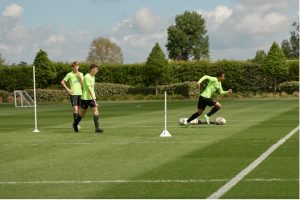In this week’s article, we will explore two Universal Collective Fundamentals (UCF) that can help us to get a better ball circulation in our attacking phase, especially during the moment of progression.
Before delving into these fundamentals, it is important to explain what UCF’s are according to the MBP School of Coaches.
The Universal Collective Fundamentals are optimal, generalised or transversal responses for the whole team, executed according to the sector of the pitch and the phase we are in (attacking or defensive).
These fundamentals are developed to help football players solve recurring situations, becoming skills to be acquired and training content.
The UCF’s are divided into three sectors of the field of play:
– Zone 1: Build-Up Zone Fundamentals
– Zone 2: Progression Zone Fundamentals
– Zone 3: Finishing Zone Fundamentals
Having explained what UCFs are, it is time to analyse two optimal responses that can help us to improve ball circulation.
Fundamental 1: Mobilising the ball when there are no favourable spaces for progression
Often, the opposition defence is very well positioned structurally, which means that there is no space inside to make progress.
In this scenario, the objective is to move the ball from the inside to the outside and vice versa, in order to move the opposition’s zonal defence and disorganise the opposition. Thanks to this, it will be possible to generate free spaces that will allow the team to progress.
However, if our attack is disorganised, the execution of this fundamental will also give our players time to reach the assigned zones of action within the given dynamic organisation (double P concept: possession to achieve position).
Fundamental 2: Adapting the tempo of circulation to the characteristics of the game
The second UCF is used throughout the attacking phase and is the responsibility of all attacking players. Its application is particularly relevant in zone 2, where the spaces for action are smaller and the execution time must be quicker.
The main objective of applying this fundamental is for the team to use an appropriate tempo of play. But what do we mean by this?
The way the ball is moved depends on the objective to be achieved. For example, the team should use a moderate pace (not slow) to move the ball safely in areas with a high density of opponents, or if a ‘pausa’ is needed to reorganise the positioning of the players.
On the other hand, a fast tempo should be used when seeking to exploit an advantage (spatial or numerical) or to surprise the opponent.
In conclusion, these 2 Universal Collective Fundamentals are essential to improve ball circulation in the attacking phase, allowing teams to play more efficiently and effectively. However, there are also other fundamentals, such as alternating short and long play and directing play towards favourable spaces, which will provide the team with greater ball fluidity.








